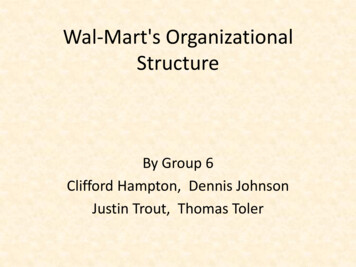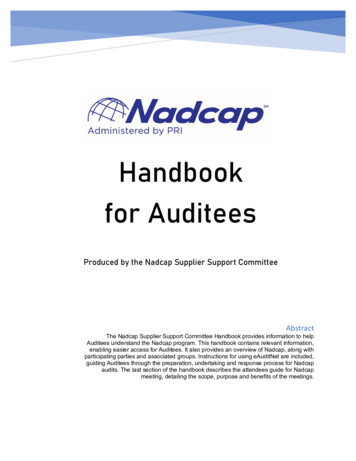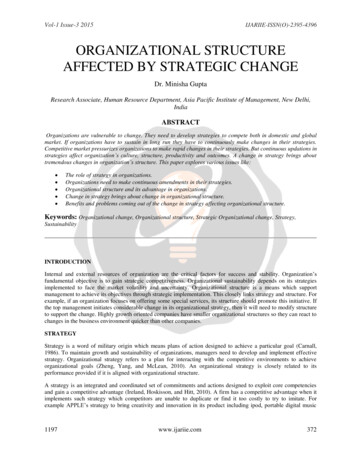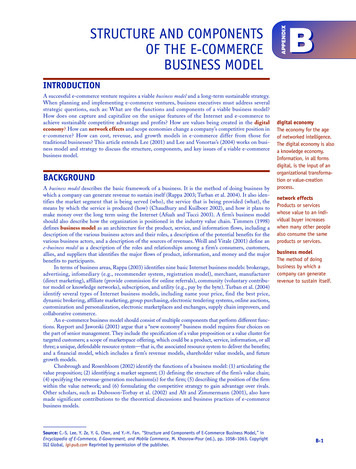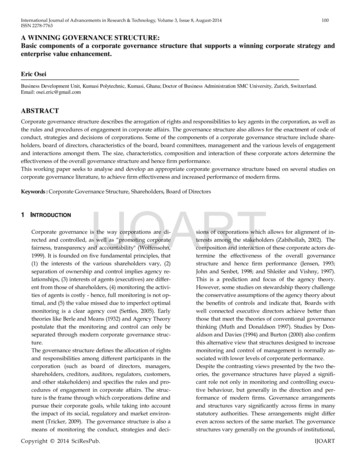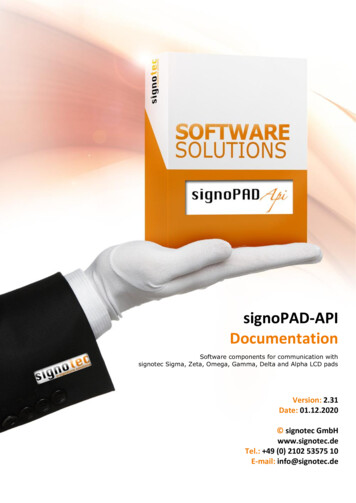
Transcription
334Chapter 10 Supply Chain Management10.1Supply ChainsA supply chain refers to the flow of materials, information, money, and services from raw material suppliers, through factories and warehouses, to the end customers. A supply chain also includesthe organizations and processes that create and deliver products, information, and services to endcustomers.The Structure and Components of Supply ChainsThe term supply chain comes from a picture of how the partnering organizations are linked together.A typical supply chain, which links a company with its suppliers and its distributors and customers,is illustrated in Figure 10.1. Recall that Figure 2.2 also illustrated a supply chain in a slightly differentway. Note that the supply chain involves three segments:1. Upstream, where sourcing or procurement from external suppliers occurs.In this segment, supply chain (SC) managers select suppliers to deliver the goods and servicesthe company needs to produce their product or service. Further, SC managers develop thepricing, delivery, and payment processes between a company and its suppliers. Included hereare processes for managing inventory, receiving and verifying shipments, transferring goodsto manufacturing facilities, and authorizing payments to suppliers.2. Internal, where packaging, assembly, or manufacturing takes place.SC managers schedule the activities necessary for production, testing, packaging, andpreparing goods for delivery. SC managers also monitor quality levels, production output, andworker productivity.3. Downstream, where distribution takes place, frequently by external distributors.In this segment, SC managers coordinate the receipt of orders from customers, develop anetwork of warehouses, select carriers to deliver their products to customers, and developinvoicing systems to receive payments from customers.The flow of information and goods can be bidirectional. For example, damaged or unwantedproducts can be returned, a process known as reverse logistics. Using the retail clothing industry asan example, reverse logistics would involve clothing that customers return, either because the itemhad defects or because the customer did not like the item.Tiers of Suppliers. If you look closely at Figure 10.1, you will notice that there are several tiersof suppliers. As the diagram shows, a supplier may have one or more subsuppliers, and the subsuppliermay have its own subsupplier(s), and so on. For example, with an automobile manufacturer, Tier 3suppliers produce basic products such as glass, plastic, and rubber. Tier 2 suppliers use these inputsto make windshields, tires, and plastic moldings. Tier 1 suppliers produce integrated componentssuch as dashboards and seat assemblies.The Flows in the Supply Chain. There are typically three flows in the supply chain: materials,information, and financial. Material flows are the physical products, raw materials, supplies, and soforth that flow along the chain. Material flows also include reverse flows (or reverse logistics)—
10.2 Supply Chain ManagementTier 3suppliersTier 2suppliersTier 1suppliers335INTERNALManufacturerDistributor orwholesalerRetailerCustomerUPSTREAMOrders, information, payments, returnsDOWNSTREAMProducts, services, informationFIGURE 10.1Generic supply chain.returned products, recycled products, and disposal of materials or products. A supply chain thusinvolves a product life cycle approach, from ―dirt to dust.‖Information flows consist of data that are related to demand, shipments, orders, returns, andschedules, as well as changes in any of these data. Finally, financial flows involve money transfers,payments, credit card information and authorization, payment schedules, e-payments, and creditrelated data.All supply chains do not have the same number and types of flows. For example, in serviceindustries there may be no physical flow of materials, but frequently there is a flow of information,often in the form of documents (physical or electronic copies). In fact, the digitization of software,music, and other content may create a supply chain without any physical flow, as we saw with Disneyin the chapter-opening case. Notice, however, that in such a case, there are two types of informationflows: one that replaces materials flow (for example, digitized software) and one that provides thesupporting information (orders, billing, and so on). To manage the supply chain an organization mustcoordinate all of the above flows among all of the parties involved in the chain.Before You Go On . . .1.2.3.10.2What is a supply chain?Describe the three segments of a supply chain.Describe the flows in a supply chain.Supply Chain ManagementThe function of supply chain management (SCM) is to plan, organize, and optimize the various activities performed along the supply chain. Like other functional areas, SCM utilizes information systems.The goal of SCM systems is to reduce the problems, or friction, along the supply chain. Friction can involveincreased time, costs, and inventories as well as decreased customer satisfaction. SCM systems, then, reduceuncertainty and risks by decreasing inventory levels and cycle time and improving business processes andcustomer service. All of these benefits make the organization more profitable and competitive.
336Chapter 10 Supply Chain ManagementSignificantly, SCM systems are a type of interorganizational information system. Aninterorganizational information system (IOS) involves information flows among two or moreorganizations. By connecting the information systems of business partners, IOSs enable the partnersto perform a number of tasks: Reduce the costs of routine business transactionsImprove the quality of the information flow by reducing or eliminating errorsCompress the cycle time involved in fulfilling business transactionsEliminate paper processing and its associated inefficiencies and costsMake the transfer and processing of information easier for usersIT’s About Business 10.1 illustrates these advantages as they apply to the supply chain of the Inditex Corporation.IT’s About Business10.1 Supply Chain Management Drives the Success of InditexSpain’s 14 billion Inditex Corporation(www.inditex.com) is one of the world’s largestfashion distributors, with eight well-knownoutlets: Zara (www.zara.com), Pull and Bear(www.pullandbear.com), Massimo Dutti (www.massimodutti.com), Bershka (www.bershka.com), Stradivarius (www.e-stradivarius.com),Oysho (www.oysho.com), Zara Home (www.zarahome.com), and Uterque (www.uterque.es). Inditex has more than 4,200 stores in 73countries. The Inditex Group is comprised ofmore than 100 companies associated with thebusiness of textile design, manufacturing, anddistribution. The mission of Inditex is to produce creative and quality designs coupled witha rapid response to market demands.Inditex, closing in on Gap as the world’slargest clothing retailer, has nearly quadrupledsales, profits, and locations since 2000. What isthe company’s secret? Besides selling relativelyinexpensive yet trendy clothes, the companyclosely monitors every link in its supply chain. Asa result, Inditex can move designs from sketchpad to store rack in as little as two weeks. This“fast fashion” process has become a model forother apparel chains, such as Los Angelesbased Forever 21 (www.forever21.com), Spain’sMango (www.mango.com), and Britain’s Topshop (www.topshop.com).Inditex has spent more than 30 years finetuning its strategy. At most clothing companies,the supply chain begins with designers, whoplan collections as much as a year in advance.In contrast, Inditex store managers monitordaily sales. With up to 70 percent of their salariescoming from commission, managers have greatincentive to respond to trends quickly and correctly. Thus, they track everything from currentsales trends to merchandise that customerswant but cannot find in stores. They then sendorders to Inditex’s 300 designers, who fashionwhat is needed almost instantly.Apparel chains typically outsource the bulk oftheir production to low-cost countries in Asia. Incontrast, Inditex produces half of its merchandise in Spain, Portugal, and Morocco, keepingthe manufacturing of the most fashionable itemsin-house while buying basics such as T-shirtsfrom shops in Eastern Europe, Africa, and Asia.Inditex also pays higher wages than its competitors. For example, its factory workers in Spainmake an average of 1650 per month, versus 206 in China’s Guandong Province, where otherapparel companies have located their factories.
10.2 Supply Chain ManagementHowever, Inditex saves time and money on shipping. Also, their plants use just-in-time systems(discussed later in this chapter) developed incooperation with logistics experts from ToyotaMotor Company.Inditex supplies all of its markets from warehouses in Spain, and the company is able toplace new merchandise in European stores within24 hours. Further, by flying goods via commercialairliners, Inditex can place new products in storesin the Americas and Asia in 48 hours or less. Shipping by air costs more than transporting bulkpackages on ocean freighters, but Inditex canafford to do so. The company produces smallerbatches of clothing, adding an air of exclusivitythat encourages customers to shop often. As aresult, the company does not have to cut pricesby 50 percent, as its rivals often must, in order tomove mass quantities of out-of-season stock.Because Inditex is more attuned to the most current looks, it can typically charge more than itscompetitors while reducing its fashion risk.Sources: Compiled from K. Capell, “Zara Thrives ByBreaking All the Rules,” BusinessWeek, October 20,3372008; “Spain’s Inditex Breaks All the Supply ChainRules,” WorldTrade Magazine, October 11, 2008;“Fashion Goes 3D,” Fortune, September 26, 2008; J.Reingold, “The British (Retail) Invasion,” Fortune, July3, 2008; “Zara’s Supply Chain Innovation,” Kaleidoscope (www.kascope.com), December 3, 2007; T.Claburn, “Math Whizzes Turbocharge an OnlineRetailer’s Sales,” InformationWeek, October 5, 2007;“Merchants of Innovation,” Crossroads 2007: SupplyChain Innovation Summit (MIT Center for Transporta-tion and Logistics), March, 2007; K. Anderson and J.Lovejoy, “The Speeding Bullet: Zara’s Apparel SupplyChain,” TechExchange, March, 2007; “Zara ShowsSupply Chain Future,” BNET.com, October 20, 2005;www.inditex.com, accessed January 20, 2009.QU ESTION S1. Describe the “fast fashion” process at Inditex.How does supply chain management enablethis process?2. Why does Inditex not have to drastically cutprices to sell out-of-season stock?3. Do you anticipate that other apparel firms willadopt similar SCM systems to Inditex? Why orwhy not?The Push Model versus the Pull ModelMany supply chain management systems use the push model. In the push model (also known as maketo-stock), the production process begins with a forecast, which is simply an educated guess as to customer demand. The forecast must predict which products customers will want as well as the quantityof each product. The company then produces the amount of products in the forecast, typically by usingmass production, and sells, or ―pushes,‖ those products to consumers.Unfortunately, these forecasts are often incorrect. Consider, for example, an automobilemanufacturer that wants to produce a new car. Marketing managers do extensive research (customersurveys, analyses of competitors’ cars) and provide the results to forecasters. If the forecasters are toohigh in their prediction—that is, they predict that sales of the new car will be 200,000 and actual customer demand turns out to be 150,000—then the automaker has 50,000 cars in inventory and will incurlarge carrying costs. Further, the company will probably have to sell the excess cars at a discount.From the opposite perspective, if the forecasters are too low in their prediction—that is, theypredict that sales of the new car will be 150,000 and actual customer demand turns out to be 200,000—then the automaker will probably have to run extra shifts to meet the demand and thus will incur largeovertime costs. Further, the company risks losing customers to competitors if the car they want is notavailable.
338Chapter 10 Supply Chain ManagementTo avoid the uncertainties associated with the push model, many companies now use Webenabled information flows to employ the pull model of supply chain management. In the pull model—also known as make-to-order—the production process begins with a customer order. Therefore,companies make only what customers want, a process closely aligned with mass customization.A prominent example of a company that uses the pull model is Dell Computer. Dell’s productionprocess begins with a customer order. This order not only specifies the type of computer the customerwants, but it also alerts each Dell supplier as to the parts of the order for which that supplier is responsible. In that way, Dell’s suppliers ship only the parts Dell needs to produce the computer.Not all companies can use the pull model. Automobiles, for example, are far more complicatedand more expensive than computers and require longer lead times to produce new models. However,using the push model in supply chain management can cause problems, as we see in the next section.Problems Along the Supply ChainAs we discussed earlier, friction can develop within a supply chain. One major consequence ofineffective supply chains is poor customer service. In some cases, supply chains do not deliver products or services when and where customers—either individuals or businesses—need them. In othercases the supply chain provides poor-quality products. Other problems associated with friction arehigh inventory costs and loss of revenues.The problems along the supply chain stem primarily from two sources: (1) uncertainties, and(2) the need to coordinate several activities, internal units, and business partners. A major sourceof supply chain uncertainties is the demand forecast. Demand for a product can be influenced bynumerous factors such as competition, prices, weather conditions, technological developments,economic conditions, and customers’ general confidence. Another uncertainty is delivery times,which depend on factors ranging from production machine failures to road construction and trafficjams. In addition, quality problems in materials and parts can create production delays, which alsolead to supply chain problems.One of the major challenges that managers face in setting accurate inventory levels throughout the supply chain is known as the bullwhip effect. The bullwhip effect refers to erratic shifts inorders up and down the supply chain (see Figure 10.2). Basically, the variables that affect customerdemand can become magnified when they are viewed through the eyes of managers at each link inOrderquantityOrderquantityTimeCustomer salesFIGURE 10.2OrderquantityOrderquantityTimeTimeRetailer ordersto wholesalerWholesaler ordersto manufacturerThe bullwhip effect.TimeManufacturer ordersto supplier
10.2 Supply Chain Managementthe supply chain. If each distinct entity that makes ordering and inventory decisions places its interests above those of the chain, then stockpiling can occur at as many as seven or eight locations alongthe chain. Research has shown that in some cases such hoarding has led to as much as a 100-daysupply of inventory that is waiting ―just in case‖ (versus 10–20 days under normal circumstances).Another problem that can adversely affect supply chains is implementing an incorrect businessmodel. IT’s About Business 10.2 shows how OfficeMax gained valuable benefits from its supply chainby redefining its business model.IT’s About Business10.2 OfficeMax Gets a Handle on Its InventoryOfficeMax (www.officemax.com) is a leadingretailer in the office products market, sellingoffice supplies and equipment to both businesses and consumers. The company operatessuperstores in 49 states and in Latin Americaand employs more than 30,000 full- and parttime workers.OfficeMax executives realize that there aremany competing office supply stores wherecustomers shop if the selection, service, or otherfactors are more attractive. In addition to thisintense competition, unanticipated shifts in themarket for computers and other business-relatedproducts, coupled with a consumer spendingslowdown due to the contracting economy, forcedthe company to reconsider key elements of itsstrategy and to analyze its business operations.This analysis revealed that the company’sbusiness model was faulty. OfficeMax hadestablished supply chain processes where itsindividual retail stores ordered products fromsuppliers, and the suppliers shipped productsdirectly to the stores. This process, known as thedirect-to-store environment, required individualstores to purchase goods in minimum quantities,which were determined by the supplier’s minimum-order quantities rather than the store’sneeds. The direct-to-store environment createda situation in which actual inventory levels weretoo high for low-turnover items and too low forhigh-turnover items. Thus, OfficeMax regularlyexperienced shortages of high-demand items,which caused customer dissatisfaction to rise tounacceptable levels. Additionally, the companyhad very high inventory carrying costs.There were many other problems with thedirect-to-store environment. The company hadno intermediate distribution points, so its entireinventory had to be located in its stores. Thisproblem was so acute that it affected store layouts. Stores had inventory stacked up to theceiling, blocking much of the lighting. Not onlydid customers not like the dimness, but theycomplained that they had difficulty navigatingthrough the store once they entered the “bigvalleys.”In addition, associates in the stores had tomanage inbound shipments rather than spending time with customers. Retail stores had towait more than a month to receive replenishmentstock, and individual stores received hundreds ofsmall shipments every week. Further, the company could not take advantage of quantity pricing from suppliers because individual stores didnot order enough products to qualify for quantity discounts. The suppliers were not satisfiedeither, because they had to ship to thousands ofplaces, a very inefficient and expensive process.To help overcome these numerous problems,OfficeMax developed a new supply chain model.The key component of the new model was theestablishment of three large intermediate distribution centers to eliminate the direct shipmentof products from vendors to stores.339
340Chapter 10 Supply Chain ManagementToday, more than 95 percent of OfficeMax’sinventory is replenished through these centers.This new arrangement has benefited the company in many ways. First, the distribution centersenable aggregation of demand across stores andhave substantially reduced the number of deliveries to each store. Also, the replenishment cycletime for OfficeMax stores has improved from 35days to 8 days. Finally, the company hasreduced 400 million in inventory.Sources: Compiled from “mySAP Supply Chain Management at OfficeMax,” SAP Case Study, www.sap.com,accessed April 4, 2009; www.officemax.com, accessedMarch 15, 2009.QU ESTION S1. Discuss the importance of analyzing acompany’s business model before analyzingits supply chain.2. Describe the problems that OfficeMax experienced with its direct-to-store supply chainmodel.3. Explain how the new supply chain model hasbenefited OfficeMax.Solutions to Supply Chain ProblemsSupply chain problems can be very costly. Therefore, organizations are motivated to find innovativesolutions. During the oil crises of the 1970s, for example, Ryder Systems, a large trucking company,purchased a refinery to control the upstream part of the supply chain and to make certain it wouldhave enough gasoline for its trucks. Ryder’s decision to purchase a refinery is an example of verticalintegration. Vertical integration is a business strategy in which a company buys its upstreamsuppliers to ensure that its essential supplies are available as soon as they are needed. Ryder latersold the refinery because it could not manage a business it did not know and because oil becamemore plentiful.Ryder’s decision to vertically integrate was not the optimal method to manage its supply chain.In the remainder of this section, we will look at some other possible solutions to supply chainproblems, many of which are supported by IT.Using Inventories to Solve Supply Chain Problems. Undoubtedly, the most commonsolution to supply chain problems is building inventories as insurance against supply chainuncertainties. The major problem with this approach is that it is very difficult to correctly determineinventory levels for each product and part. If inventory levels are set too high, the costs of keepingthe inventory will greatly increase. (Also, as we have seen, excessive inventories at multiple pointsin the supply chain can result in the bullwhip effect.) If the inventory is too low, there is no insuranceagainst high demand or slow delivery times. In such cases, customers don’t receive what they want,when they want or need it. The result is lost customers and lost revenues. In either event, the totalcost—including the costs of maintaining inventories, the costs of lost sales opportunities, and thecosts of developing a bad reputation—can be very high. Thus, companies make major attempts tooptimize and control inventories.A well-known initiative to optimize and control inventories is the just-in-time (JIT) inventorysystem, which attempts to minimize inventories. That is, in a manufacturing process, JIT systemsdeliver the precise number of parts, called work-in-process inventory, to be assembled into a finishedproduct at precisely the right time.
10.3 Information Technology Support for Supply Chain ManagementInformation Sharing. Another common way to solve supply chain problems, and especiallyto improve demand forecasts, is sharing information along the supply chain. Information sharing canbe facilitated by electronic data interchange and extranets, topics we discuss in the next section.One of the most notable examples of information sharing occurs between large manufacturers and retailers. For example, Wal-Mart provides Procter & Gamble with access to daily salesinformation from every store for every item P&G makes for Wal-Mart. This access enables P&G tomanage the inventory replenishment for Wal-Mart’s stores. By monitoring inventory levels, P&Gknows when inventories fall below the threshold for each product at any Wal-Mart store. These datatrigger an immediate shipment.Information sharing between Wal-Mart and P&G is done automatically. It is part of a vendormanaged inventory strategy. Vendor-managed inventory (VMI) occurs when a retailer does notmanage the inventory for a particular product or group of products. Instead, the supplier managesthe entire inventory process. P&G has similar agreements with other major retailers. The benefit forP&G is accurate and timely information on consumer demand for its products. Thus, P&G can planproduction more accurately, minimizing the bullwhip effect.Before You Go On . . .1.2.3.10.3Differentiate between the push model and the pull model.Describe various problems that can occur along the supply chain.Discuss possible solutions to problems along the supply chain.Information Technology Support for Supply ChainManagementClearly, SCM systems are essential to the successful operation of many businesses. As we discussed,these systems—and IOSs in general—rely on various forms of IT to resolve problems. Three technologies in particular provide support for IOSs and SCM systems: electronic data interchange,extranets, and Web services. We already discussed Web services in Chapter 5. In this section we examine the other two technologies.Electronic Data Interchange (EDI)Electronic data interchange (EDI) is a communication standard that enables business partners toexchange routine documents, such as purchasing orders, electronically. EDI formats these documentsaccording to agreed-upon standards (for example, data formats). It then transmits messages usinga converter, called a translator. The message travels over either a value-added network (VAN) or theInternet.EDI provides many benefits compared with a manual delivery system (see Figure 10.3). Tobegin with, it minimizes data entry errors, because each entry is checked by the computer. In addition, the length of the message can be shorter, and the messages are secured. EDI also reduces cycletime, increases productivity, enhances customer service, and minimizes paper usage and storage.341
342Chapter 10 Supply Chain ManagementWITHOUT EDIStartP.O.deliverySalesOrder placerAccounting/financeOrder confirmationbill deliveryMailroomPurchasingAccounting/financeMail t deliveryOrder fulfillmentBuyerSellerWITH EDIComputer convertergeneratesstandardizedP.O. formStandardizedP.O. formFlashreportInvoiceStartInstantdata to sales inventory manufacturing engineeringEDI converterDepartmentalbuyerReceivingOrder fulfillmentProduct deliveryShippingBuyerSellerFIGURE 10.3Comparing purchase order (PO) fullfilment with and without EDI.Source: Drawn by E. Turban.Despite all of the advantages of EDI, several factors have prevented it from being more widelyused. To begin with, implementing an EDI system involves a significant initial investment. Inaddition, the ongoing operating costs also are high, due to the use of expensive, private VANs.Another major issue for some companies is that the traditional EDI system is inflexible. For example,it is difficult to make quick changes, such as adding business partners. In addition, an EDI system
10.3 Information Technology Support for Supply Chain Managementrequires a long startup period. Further, business processes must sometimes be restructured to fit EDI requirements. Finally, there are many EDI standards in use today. As aresult, one company might have to use several standards in order to communicate withdifferent business partners.EDI is especially problematic for small businesses, for several reasons. First, manyEDI systems require support from specialized IT experts who spend an inordinateamount of time fine-tuning the data-exchange process. This requirement places the costsof implementing EDI beyond the reach of many smaller organizations. Another problem for smaller organizations arises if their larger supply chain partners mandated thatall participants in their supply chains invest in and utilize EDI technology. Thus, smallerorganizations must either adopt EDI technology, regardless of the cost, or lose significant business partners.Despite these complications, EDI remains popular, particularly among majorbusiness partners, though it is being replaced by XML-based Web services. (We discussXML in Technology Guide 2). In fact, many EDI service providers offer secure, lowcost EDI services over the Internet, as IT’s About Business 10.3 shows.IT’s About Business10.3 Mount Vernon Mills Adopts EDIMount Vernon Mills (www.mvmills.com) manufactures textile products for the apparel, industrial, institutional, and commercial markets. Thecompany has approximately 3,600 employeesand operates 14 production facilities in the U.S.The firm recently faced an EDI dilemma. On theone hand, could it afford to integrate EDI systems into its corporate IT infrastructure to support connectivity with its larger supply chainpartners? On the other hand, would its smallersuppliers feel pressured or disenfranchised if thecompany moved to EDI as its preferred meansof data exchange?After extensive research into EDI systems,Mount Vernon Mills deployed EDI Integrator, acomprehensive EDI solution provider developedby EXTOL (www.extol.com). To implement EDIIntegrator, Mount Vernon Mills had to upgrade itsinfrastructure and strategically realign its ITresources. To achieve these objectives, thecompany consolidated its IT resources into asingle location—its corporate headquarters inMaudlin, South Carolina. This process allowedthe company to eliminate overhead and duplication of resources. Moreover, with the implementation of the new EDI system, all data fromits supply chain partners were routed through asingle location and a single system.The EDI Integrator also enabled Mount Vernon Mills to exchange data instantaneously andcost effectively with its supply chain partnerswho were EDI-enabled. At the same time, thesystem was flexible enough to transmit nontraditional EDI documents such as spreadsheets,flat files, and even e-mails.After the deployment was complete and thesystem was fully functional, Mount Vernon Millswas able to process orders much more efficiently. In addition, the system reduced the number of labor-intensive hours dedicated tore-entering hard copy data from both customersand suppliers.343
344Chapter 10 Supply Chain ManagementSources: Complied from J. Utsler, “Grist for the Mill,”IBM Systems Magazine, April 2009; “Mount VernonQU ESTION S1. Should a company ensure connectivity withlarger supply chain partners at the risk of losing connectivity with smaller supply chainpartners? Is there a middle ground? Supportyour answer.2. What benefits did Mount Vernon Mills realizefrom implementing EDI?Mills Selects EXTOL To Execute a Total Customer Satisfaction Supply Chain Strategy,” EXTOL CustomerSuccess Story, June 2008; www.mvmills.com andwww.extol.com, accessed April 3, 2009.ExtranetsTo implement IOSs and SCM systems, a company must connect the intranets of its various businesspartners to create extranets. As we have discussed in previous chapters, extranets link businesspartners to one another over the Internet by providing access to certain areas of one another’scorporate intranets (see Figure 10.4).The primary goal of extranets is to foster collaboration between and among business partners.An extranet is open to selected B2B suppliers, customer
334 Chapter 10 Supply Chain Management 10.1 Supply Chains A supply chain refers to the flow of materials, information, money, and services from raw mate- rial suppliers, through factories and warehouses, to the end customers. A supply chain also includes the organizations and processes that crea



